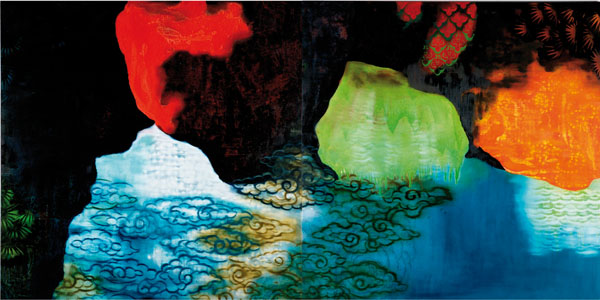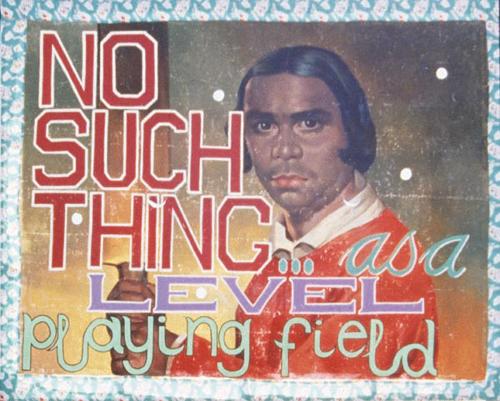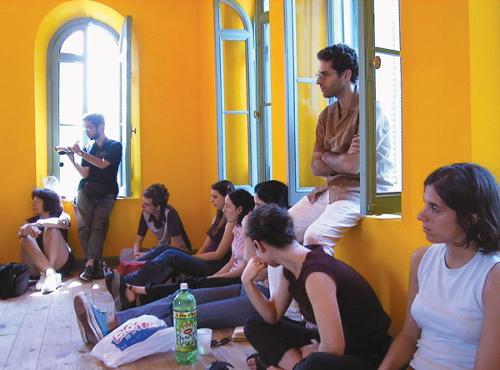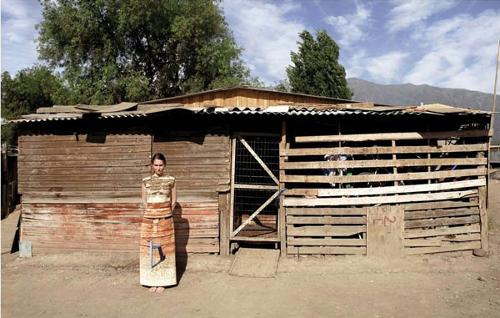
Aboriginal and settler Australians share the same place, and issues such as water, which this exhibition addresses, are important to each. So it should be no surprise that exhibitions combining Aboriginal and settler art are now commonplace. Yet each remains distinct from the other, despite the increasing tendency of Aboriginal art towards the aestheticised compositions of modernism, and settler art picking up on Aboriginal patterns, rhythms and colours. In this exhibition Richard Woldendorp's aerial photographs are a good example of the latter. While they have that Aboriginal 'look', they lack the intimate tactility of Aboriginal art: they are ethereal, not the imprint of dreaming; they seduce the eyes but are not to be touched, sung and danced. They conjure an abstract sublime beauty through which setters have fashioned a unique spiritual feeling for Aboriginal Australia. As in many such settler images, there is a funereal silence, a longing and loss rather than fullness. No other nation has perfected such an austere primeval vision of itself.
On the other hand, the Aboriginal paintings, especially those from Balgo and by the Mangkaja artist Wakartu Cory Surprise, are much noisier affairs as if the land is a concert beating out a rhythm, loud and lyrical, dancing and singing.
Nearly every Aboriginal painting pictures life, while the settler artists prefer death. An exception is Susie Marwick's small picturesque scenes on used sardine tins, which depict the harbour and beaches of Fremantle, cute lively sketches of a happy prosperous trouble-free European settlement. Another exception is Graham (Swag) Taylor's 'Tijnang koomba kep (Looking to the big water)', which depicts Bunbury as imagined before contact time. Painted in the magic realist style of Nyoongar landscape painting, it has a melancholy mood as if the artist's memories of good times are soured by the crushing loss of what has happened since.
But whatever their differences, all the artworks are about water. For the Aboriginal artists in the exhibition, who mostly come from the northwestern desert regions of Australia, water is in every painting like the sun is in the sky. It is in the air and soil, plants and animals: it is the lifeblood of dreaming. The anthropologist Emmaline Schooeveldt-Reid wrote in the exhibition pamphlet, 'almost every place they name has water, and I find myself floundering in a new language and iconography of pools, rockholes, claypans, soaks, wells, washaways, run throughs, lakes and marshes. I am stretching my English to take in the many ways water lies within this red hot landscape.' Water is also the medium that, for Nyoongar artist Mullark (Barry McGuire), holds various (now hidden) ceremonial sites in Perth together as if they are all of one skin, a metaphysical soak of interconnecting veins.
However water plays a very different role in settler art. Take Grant Currall's photographs of salinity in the West Australian wheatbelt. These thoughtfully composed works with their dense light are familiar outback images, but archetypal rather than specific. Even locals, he told me, have difficulty pinpointing their location. He has pictured an abandoned place, the inhabitants gone and the salt carried by the water like poison in the veins. Everything looks still and photogenic; in fact it is slowly crumbling, the few remaining uncleared trees, the wetlands, the animals, even the buildings, roads and soil. Currall was most struck by the deathly silence of these vast tracts of decimated land. Whether the working dog cemetery, the stark shadows on the walls of condemned buildings or the scarred earth itself, death haunts this saltwater landscape. Again the sublime is made a substitute for an attachment to place; again death is chosen over life – an afterlife instead of the ever present dreaming. Two visions in the balance; how will it turn?
'I am that living water, that spring water, you are that travelling water, that river water that comes with the rain and flows away.'
(Patrick Mung Mung)












